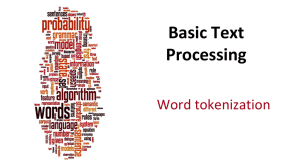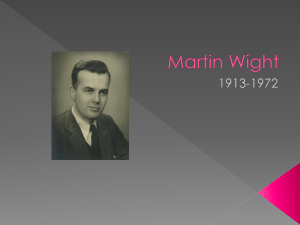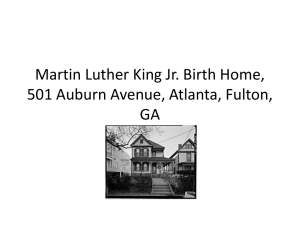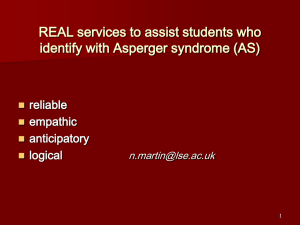slp08
advertisement
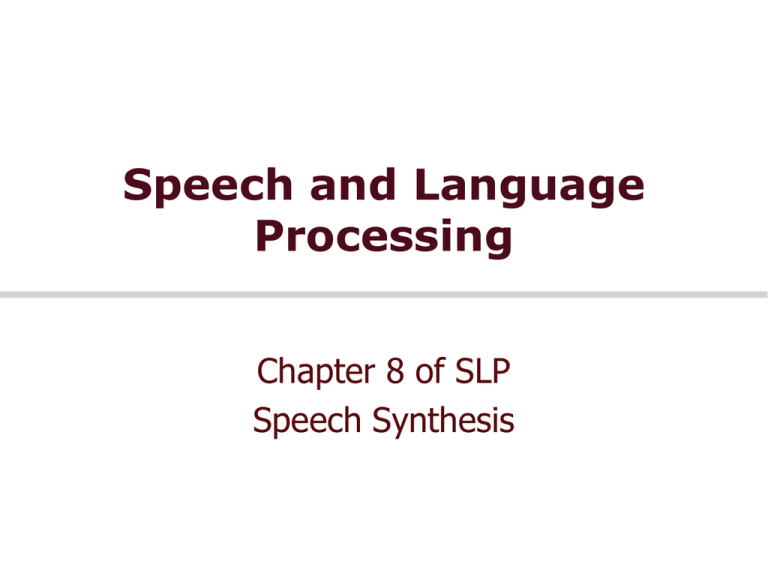
Speech and Language Processing Chapter 8 of SLP Speech Synthesis Outline 1) Arpabet 2) TTS Architectures 3) TTS Components • Text Analysis • • • • Text Normalization Homonym Disambiguation Grapheme-to-Phoneme (Letter-to-Sound) Intonation • Waveform Generation • Unit Selection • Diphones 4/6/2015 Speech and Language Processing Jurafsky and Martin 2 Dave Barry on TTS “And computers are getting smarter all the time; scientists tell us that soon they will be able to talk with us. (By "they", I mean computers; I doubt scientists will ever be able to talk to us.) 4/6/2015 Speech and Language Processing Jurafsky and Martin 3 ARPAbet Vowels 1 2 3 4 5 6 7 8 4/6/2015 b_d bead bid bayed bed bad bod(y) bawd Budd(hist) ARPA iy ih ey eh ae aa ao uh 9 10 11 12 13 14 15 b_d bode booed bud bird bide bowed Boyd ARPA ow uw ah er ay aw oy Speech and Language Processing Jurafsky and Martin 4 Brief Historical Interlude • Pictures and some text from Hartmut Traunmüller’s web site: • http://www.ling.su.se/staff/hartmut/kemplne.htm • Von Kempeln 1780 b. Bratislava 1734 d. Vienna 1804 • Leather resonator manipulated by the operator to copy vocal tract configuration during sonorants (vowels, glides, nasals) • Bellows provided air stream, counterweight provided inhalation • Vibrating reed produced periodic pressure wave 4/6/2015 Speech and Language Processing Jurafsky and Martin 5 Von Kempelen: • Small whistles controlled consonants • Rubber mouth and nose; nose had to be covered with two fingers for non-nasals • Unvoiced sounds: mouth covered, auxiliary bellows driven by string provides puff of air From Traunmüller’s web site 4/6/2015 Speech and Language Processing Jurafsky and Martin 6 Modern TTS systems 1960’s first full TTS: Umeda et al (1968) 1970’s Joe Olive 1977 concatenation of linear-prediction diphones Speak and Spell 1980’s 1979 MIT MITalk (Allen, Hunnicut, Klatt) 1990’s-present Diphone synthesis Unit selection synthesis 4/6/2015 Speech and Language Processing Jurafsky and Martin 7 2. Overview of TTS: Architectures of Modern Synthesis Articulatory Synthesis: Model movements of articulators and acoustics of vocal tract Formant Synthesis: Start with acoustics, create rules/filters to create each formant Concatenative Synthesis: Use databases of stored speech to assemble new utterances. 4/6/2015 Text from Richard Sproat slides Speech and Language Processing Jurafsky and Martin 8 Formant Synthesis Were the most common commercial systems while computers were relatively underpowered. 1979 MIT MITalk (Allen, Hunnicut, Klatt) 1983 DECtalk system The voice of Stephen Hawking 4/6/2015 Speech and Language Processing Jurafsky and Martin 9 Concatenative Synthesis All current commercial systems. Diphone Synthesis Units are diphones; middle of one phone to middle of next. Why? Middle of phone is steady state. Record 1 speaker saying each diphone Unit Selection Synthesis Larger units Record 10 hours or more, so have multiple copies of each unit Use search to find best sequence of units 4/6/2015 Speech and Language Processing Jurafsky and Martin 10 TTS Demos (all are Unit-Selection) Festival http://www-2.cs.cmu.edu/~awb/festival_demos/index.html Cepstral http://www.cepstral.com/cgibin/demos/general IBM http://www-306.ibm.com/software/pervasive/tech/demos/tts.shtml 4/6/2015 Speech and Language Processing Jurafsky and Martin 11 Architecture The three types of TTS Concatenative Formant Articulatory Only cover the segments+f0+duration to waveform part. A full system needs to go all the way from random text to sound. 4/6/2015 Speech and Language Processing Jurafsky and Martin 12 Two steps PG&E will file schedules on April 20. TEXT ANALYSIS: Text into intermediate representation: WAVEFORM SYNTHESIS: From the intermediate representation into waveform 4/6/2015 Speech and Language Processing Jurafsky and Martin 13 The Hourglass 4/6/2015 Speech and Language Processing Jurafsky and Martin 14 1. Text Normalization Analysis of raw text into pronounceable words: Sentence Tokenization Text Normalization 4/6/2015 Identify tokens in text Chunk tokens into reasonably sized sections Map tokens to words Identify types for words Speech and Language Processing Jurafsky and Martin 15 Rules for end-of-utterance detection A dot with one or two letters is an abbrev A dot with 3 cap letters is an abbrev. An abbrev followed by 2 spaces and a capital letter is an end-of-utterance Non-abbrevs followed by capitalized word are breaks This fails for Cog. Sci. Newsletter Lots of cases at end of line. Badly spaced/capitalized sentences 4/6/2015 From Alan Black lecture notes Speech and Language Processing Jurafsky and Martin 16 Decision Tree: is a word end-of-utterance? 4/6/2015 Speech and Language Processing Jurafsky and Martin 17 Learning Decision Trees DTs are rarely built by hand Hand-building only possible for very simple features, domains Lots of algorithms for DT induction 4/6/2015 Speech and Language Processing Jurafsky and Martin 18 Next Step: Identify Types of Tokens, and Convert Tokens to Words Pronunciation of numbers often depends on type: 1776 date: seventeen seventy six. 1776 phone number: one seven seven six 1776 quantifier: one thousand seven hundred (and) seventy six 25 day: twenty-fifth 4/6/2015 Speech and Language Processing Jurafsky and Martin 19 Classify token into 1 of 20 types EXPN: abbrev, contractions (adv, N.Y., mph, gov’t) LSEQ: letter sequence (CIA, D.C., CDs) ASWD: read as word, e.g. CAT, proper names MSPL: misspelling NUM: number (cardinal) (12,45,1/2, 0.6) NORD: number (ordinal) e.g. May 7, 3rd, Bill Gates II NTEL: telephone (or part) e.g. 212-555-4523 NDIG: number as digits e.g. Room 101 NIDE: identifier, e.g. 747, 386, I5, PC110 NADDR: number as stresst address, e.g. 5000 Pennsylvania NZIP, NTIME, NDATE, NYER, MONEY, BMONY, PRCT,URL,etc SLNT: not spoken (KENT*REALTY) 4/6/2015 Speech and Language Processing Jurafsky and Martin 20 More about the types 4 categories for alphabetic sequences: EXPN: expand to full word or word seq (fplc for fireplace, NY for New York) LSEQ: say as letter sequence (IBM) ASWD: say as standard word (either OOV or acronyms) 5 main ways to read numbers: Cardinal (quantities) Ordinal (dates) String of digits (phone numbers) Pair of digits (years) Trailing unit: serial until last non-zero digit: 8765000 is “eight seven six five thousand” (some phone numbers, long addresses) But still exceptions: (947-3030, 830-7056) 4/6/2015 Speech and Language Processing Jurafsky and Martin 21 Finally: expanding NSW Tokens Type-specific heuristics ASWD expands to itself LSEQ expands to list of words, one for each letter NUM expands to string of words representing cardinal NYER expand to 2 pairs of NUM digits… NTEL: string of digits with silence for puncutation Abbreviation: use abbrev lexicon if it’s one we’ve seen Else use training set to know how to expand Cute idea: if “eat in kit” occurs in text, “eat-in kitchen” will also occur somewhere. 4/6/2015 Speech and Language Processing Jurafsky and Martin 22 2. Homograph disambiguation 19 most frequent homographs, from Liberman and Church use increase close record house contract lead 131 live lives105 protest 319 230 215 195 150 143 130 94 survey project separate present 80 read subject rebel finance estimate 91 90 87 72 68 48 46 46 Not a huge problem, but still important 4/6/2015 Speech and Language Processing Jurafsky and Martin 23 POS Tagging for homograph disambiguation Many homographs can be distinguished by POS 4/6/2015 use y uw s close k l ow s house h aw s live l ay v REcord INsult OBject OVERflow DIScount CONtent y uw z k l ow z h aw z l ih v reCORD inSULT obJECT overFLOW disCOUNT conTENT Speech and Language Processing Jurafsky and Martin 24 3. Letter-to-Sound: Getting from words to phones Two methods: Dictionary-based Rule-based (Letter-to-sound=LTS) Early systems, all LTS MITalk was radical in having huge 10K word dictionary Now systems use a combination 4/6/2015 Speech and Language Processing Jurafsky and Martin 25 Pronunciation Dictionaries: CMU CMU dictionary: 127K words http://www.speech.cs.cmu.edu/cgi-bin/cmudict Some problems: Has errors Only American pronunciations No syllable boundaries Doesn’t tell us which pronunciation to use for which homophones (no POS tags) Doesn’t distinguish case The word US has 2 pronunciations [AH1 S] and [Y UW1 EH1 S] 4/6/2015 Speech and Language Processing Jurafsky and Martin 26 Pronunciation Dictionaries: UNISYN UNISYN dictionary: 110K words (Fitt 2002) http://www.cstr.ed.ac.uk/projects/unisyn/ Benefits: Has syllabification, stress, some morphological boundaries Pronunciations can be read off in General American RP British Australia Etc (Other dictionaries like CELEX not used because too small, Britishonly) 4/6/2015 Speech and Language Processing Jurafsky and Martin 27 Dictionaries aren’t sufficient Unknown words (= OOV = “out of vocabulary”) Increase with the (sqrt of) number of words in unseen text Black et al (1998) OALD on 1st section of Penn Treebank: Out of 39923 word tokens, 1775 tokens were OOV: 4.6% (943 unique types): names unknown Typos/other 1360 351 64 76.6% 19.8% 3.6% So commercial systems have 4-part system: 4/6/2015 Big dictionary Names handled by special routines Acronyms handled by special routines (previous lecture) Machine learned g2p algorithm for other unknown words Speech and Language Processing Jurafsky and Martin 28 Names Big problem area is names Names are common 20% of tokens in typical newswire text will be names 1987 Donnelly list (72 million households) contains about 1.5 million names Personal names: McArthur, D’Angelo, Jiminez, Rajan, Raghavan, Sondhi, Xu, Hsu, Zhang, Chang, Nguyen Company/Brand names: Infinit, Kmart, Cytyc, Medamicus, Inforte, Aaon, Idexx Labs, Bebe 4/6/2015 Speech and Language Processing Jurafsky and Martin 29 Names Methods: Can do morphology (Walters -> Walter, Lucasville) Can write stress-shifting rules (Jordan -> Jordanian) Rhyme analogy: Plotsky by analogy with Trostsky (replace tr with pl) Liberman and Church: for 250K most common names, got 212K (85%) from these modified-dictionary methods, used LTS for rest. Can do automatic country detection (from letter trigrams) and then do country-specific rules Can train g2p system specifically on names Or specifically on types of names (brand names, Russian names, etc) 4/6/2015 Speech and Language Processing Jurafsky and Martin 30 Acronyms We saw above Use machine learning to detect acronyms EXPN ASWORD LETTERS Use acronym dictionary, hand-written rules to augment 4/6/2015 Speech and Language Processing Jurafsky and Martin 31 Letter-to-Sound Rules Earliest algorithms: handwritten Chomsky+Halle-style rules: Festival version of such LTS rules: (LEFTCONTEXT [ ITEMS] RIGHTCONTEXT = NEWITEMS ) Example: (#[ch]C=k) ( # [ c h ] = ch ) # denotes beginning of word C means all consonants Rules apply in order “christmas” pronounced with [k] But word with ch followed by non-consonant pronounced [ch] E.g., “choice” 4/6/2015 Speech and Language Processing Jurafsky and Martin 32 Stress rules in hand-written LTS English famously evil: one from Allen et al 1987 Where X must contain all prefixes: Assign 1-stress to the vowel in a syllable preceding a weak syllable followed by a morpheme-final syllable containing a short vowel and 0 or more consonants (e.g. difficult) Assign 1-stress to the vowel in a syllable preceding a weak syllable followed by a morpheme-final vowel (e.g. oregano) etc 4/6/2015 Speech and Language Processing Jurafsky and Martin 33 Modern method: Learning LTS rules automatically Induce LTS from a dictionary of the language Black et al. 1998 Applied to English, German, French Two steps: alignment (CART-based) rule-induction 4/6/2015 Speech and Language Processing Jurafsky and Martin 34 Alignment Letters: c h e c k e d Phones: ch _ eh _ k _ t Black et al Method 1: First scatter epsilons in all possible ways to cause letters and phones to align Then collect stats for P(phone|letter) and select best to generate new stats This iterated a number of times until settles (5-6) This is EM (expectation maximization) alg 4/6/2015 Speech and Language Processing Jurafsky and Martin 35 Alignment: Black et al method 2 Hand specify which letters can be rendered as which phones C goes to k/ch/s/sh W goes to w/v/f, etc An actual list: Once mapping table is created, find all valid alignments, find p(letter|phone), score all alignments, take best 4/6/2015 Speech and Language Processing Jurafsky and Martin 36 Alignment Some alignments will turn out to be really bad. These are just the cases where pronunciation doesn’t match letters: Dept d ih p aa r t m ah n t CMU s iy eh m y uw Lieutenant l eh f t eh n ax n t (British) Also foreign words These can just be removed from alignment training 4/6/2015 Speech and Language Processing Jurafsky and Martin 37 Building CART trees Build a CART tree for each letter in alphabet (26 plus accented) using context of +-3 letters # # # c h e c -> ch c h e c k e d -> _ 4/6/2015 Speech and Language Processing Jurafsky and Martin 38 Add more features Even more: for French liaison, we need to know what the next word is, and whether it starts with a vowel French ‘six’ [s iy s] in j’en veux six [s iy z] in six enfants [s iy] in six filles 4/6/2015 Speech and Language Processing Jurafsky and Martin 39 Prosody: from words+phones to boundaries, accent, F0, duration Prosodic phrasing Need to break utterances into phrases Punctuation is useful, not sufficient Accents: Predictions of accents: which syllables should be accented Realization of F0 contour: given accents/tones, generate F0 contour Duration: Predicting duration of each phone 4/6/2015 Speech and Language Processing Jurafsky and Martin 40 Defining Intonation Ladd (1996) “Intonational phonology” “The use of suprasegmental phonetic features Suprasegmental = above and beyond the segment/phone F0 Intensity (energy) Duration to convey sentence-level pragmatic meanings” i.e. meanings that apply to phrases or utterances as a whole, not lexical stress, not lexical tone. 4/6/2015 Speech and Language Processing Jurafsky and Martin 41 Three aspects of prosody Prominence: some syllables/words are more prominent than others Structure/boundaries: sentences have prosodic structure Some words group naturally together Others have a noticeable break or disjuncture between them Tune: the intonational melody of an utterance. 4/6/2015 From Ladd (1996) Speech and Language Processing Jurafsky and Martin 42 Prosodic Prominence: Pitch Accents A: What types of foods are a good source of vitamins? B1: Legumes are a good source of VITAMINS. B2: LEGUMES are a good source of vitamins. • Prominent syllables are: • • • 4/6/2015 Louder Longer Have higher F0 and/or sharper changes in F0 (higher F0 velocity) Slide from Jennifer Venditti Speech and Language Processing Jurafsky and Martin 43 Stress vs. accent (2) The speaker decides to make the word vitamin more prominent by accenting it. Lexical stress tell us that this prominence will appear on the first syllable, hence VItamin. 4/6/2015 Speech and Language Processing Jurafsky and Martin 44 Which word receives an accent? It depends on the context. For example, the ‘new’ information in the answer to a question is often accented, while the ‘old’ information usually is not. Q1: What types of foods are a good source of vitamins? A1: LEGUMES are a good source of vitamins. Q2: Are legumes a source of vitamins? A2: Legumes are a GOOD source of vitamins. Q3: I’ve heard that legumes are healthy, but what are they a good source of ? A3: Legumes are a good source of VITAMINS. 4/6/2015 Slide from Jennifer Venditti Speech and Language Processing Jurafsky and Martin 45 Factors in accent prediction Part of speech: Content words are usually accented Function words are rarely accented Of, for, in on, that, the, a, an, no, to, and but or will may would can her is their its our there is am are was were, etc 4/6/2015 Speech and Language Processing Jurafsky and Martin 46 Complex Noun Phrase Structure Sproat, R. 1994. English noun-phrase accent prediction for text-to-speech. Computer Speech and Language 8:79-94. Proper Names, stress on right-most word New York CITY; Paris, FRANCE Adjective-Noun combinations, stress on noun Large HOUSE, red PEN, new NOTEBOOK Noun-Noun compounds: stress left noun HOTdog (food) versus HOT DOG (overheated animal) WHITE house (place) versus WHITE HOUSE (made of stucco) examples: MEDICAL Building, APPLE cake, cherry PIE. What about: Madison avenue, Park street ??? Some Rules: Furniture+Room -> RIGHT (e.g., kitchen TABLE) Proper-name + Street -> LEFT (e.g. PARK street) 4/6/2015 Speech and Language Processing Jurafsky and Martin 47 State of the art Hand-label large training sets Use CART, SVM, CRF, etc to predict accent Lots of rich features from context (parts of speech, syntactic structure, information structure, contrast, etc.) Classic lit: Hirschberg, Julia. 1993. Pitch Accent in context: predicting intonational prominence from text. Artificial Intelligence 63, 305-340 4/6/2015 Speech and Language Processing Jurafsky and Martin 48 Levels of prominence Most phrases have more than one accent The last accent in a phrase is perceived as more prominent Emphatic accents like nuclear accent often used for semantic purposes, such as indicating that a word is contrastive, or the semantic focus. Reduced words, especially function words. Often use 4 classes of prominence: 1. 2. 3. 4. 4/6/2015 The kind of thing you represent via ***s in IM, or capitalized letters ‘ I know SOMETHING interesting is sure to happen,’ she said to herself. Can also have words that are less prominent than usual Called the Nuclear Accent emphatic accent, pitch accent, unaccented, reduced Speech and Language Processing Jurafsky and Martin 49 Yes-No question 550 500 450 400 350 300 250 200 150 100 50 are legumes a good source of VITAMINS Rise from the main accent to the end of the sentence. 4/6/2015 Slide from Jennifer Venditti Speech and Language Processing Jurafsky and Martin 50 ‘Surprise-redundancy’ tune [How many times do I have to tell you ...] 400 350 300 250 200 150 100 50 legumes are a good source of vitamins Low beginning followed by a gradual rise to a high at the end. 4/6/2015 Slide from Jennifer Venditti Speech and Language Processing Jurafsky and Martin 51 ‘Contradiction’ tune “I’ve heard that linguini is a good source of vitamins.” 400 350 300 250 200 150 100 50 linguini isn’t a good source of vitamins [... how could you think that?] Sharp fall at the beginning, flat and low, then rising at the end. 4/6/2015 Slide from Jennifer Venditti Speech and Language Processing Jurafsky and Martin 52 Duration Simplest: fixed size for all phones (100 ms) Next simplest: average duration for that phone (from training data). Samples from SWBD in ms: aa ax ay eh ih 118 59 138 87 77 b d dh f g 68 68 44 90 66 Next Next Simplest: add in phrase-final and initial lengthening plus stress: 4/6/2015 Speech and Language Processing Jurafsky and Martin 53 Intermediate representation: using Festival Do you really want to see all of it? 4/6/2015 Speech and Language Processing Jurafsky and Martin 54 Waveform Synthesis Given: String of phones Prosody Desired F0 for entire utterance Duration for each phone Stress value for each phone, possibly accent value Generate: Waveforms 4/6/2015 Speech and Language Processing Jurafsky and Martin 55 Diphone TTS architecture Training: Choose units (kinds of diphones) Record 1 speaker saying 1 example of each diphone Mark the boundaries of each diphones, cut each diphone out and create a diphone database Synthesizing an utterance, grab relevant sequence of diphones from database Concatenate the diphones, doing slight signal processing at boundaries use signal processing to change the prosody (F0, energy, duration) of selected sequence of diphones 4/6/2015 Speech and Language Processing Jurafsky and Martin 56 Diphones Mid-phone is more stable than edge: 4/6/2015 Speech and Language Processing Jurafsky and Martin 57 Diphones mid-phone is more stable than edge Need O(phone2) number of units Some combinations don’t exist (hopefully) ATT (Olive et al. 1998) system had 43 phones 1849 possible diphones Phonotactics ([h] only occurs before vowels), don’t need to keep diphones across silence Only 1172 actual diphones May include stress, consonant clusters So could have more Lots of phonetic knowledge in design Database relatively small (by today’s standards) Around 8 megabytes for English (16 KHz 16 bit) 4/6/2015 Slide from Richard Sproat Speech and Language Processing Jurafsky and Martin 58 Voice Speaker Called a voice talent Diphone database Called a voice 4/6/2015 Speech and Language Processing Jurafsky and Martin 59 Prosodic Modification Modifying pitch and duration independently Changing sample rate modifies both: Chipmunk speech Duration: duplicate/remove parts of the signal Pitch: resample to change pitch 4/6/2015 Text from Alan Black 60 Speech and Language Processing Jurafsky and Martin Speech as Short Term signals 4/6/2015 Alan Black Speech and Language Processing Jurafsky and Martin 61 Duration modification Duplicate/remove short term signals 4/6/2015 Slide from Richard Spro 62 Speech and Language Processing Jurafsky and Martin Duration modification Duplicate/remove short term signals 4/6/2015 Speech and Language Processing Jurafsky and Martin 63 Pitch Modification Move short-term signals closer together/further apart 4/6/2015 Slide from Richard Sproat Speech and Language Processing Jurafsky and Martin 64 TD-PSOLA ™ Time-Domain Pitch Synchronous Overlap and Add Patented by France Telecom (CNET) Very efficient No FFT (or inverse FFT) required Can modify Hz up to two times or by half 4/6/2015 Slide from Richard Sproat Speech and Language Processing Jurafsky and Martin 65 TD-PSOLA ™ Time-Domain Pitch Synchronous Overlap and Add Patented by France Telecom (CNET) Windowed Pitch-synchronous Overlap-and-add Very efficient Can modify Hz up to two times or by half 4/6/2015 Speech and Language Processing Jurafsky and Martin 66 Unit Selection Synthesis Generalization of the diphone intuition Larger units From diphones to sentences Many many copies of each unit 10 hours of speech instead of 1500 diphones (a few minutes of speech) 4/6/2015 Speech and Language Processing Jurafsky and Martin 67 Unit Selection Intuition Given a big database Find the unit in the database that is the best to synthesize some target segment What does “best” mean? “Target cost”: Closest match to the target description, in terms of Phonetic context F0, stress, phrase position “Join cost”: Best join with neighboring units Matching formants + other spectral characteristics Matching energy Matching F0 4/6/2015 Speech and Language Processing Jurafsky and Martin 68 Targets and Target Costs Target cost T(ut,st): How well the target specification st matches the potential unit in the database ut Features, costs, and weights Examples: /ih-t/ +stress, phrase internal, high F0, content word /n-t/ -stress, phrase final, high F0, function word /dh-ax/ -stress, phrase initial, low F0, word “the” 4/6/2015 Speech and Language Processing Jurafsky and Martin 69 Target Costs Comprised of k subcosts Stress Phrase position F0 Phone duration Lexical identity Target cost for a unit: p C ( ti, ui ) t t t w k C k (t i , u i ) k1 4/6/2015 Slide from Paul Taylor Speech and Language Processing Jurafsky and Martin 70 Join (Concatenation) Cost Measure of smoothness of join Measured between two database units (target is irrelevant) Features, costs, and weights Comprised of k subcosts: Spectral features F0 Energy Join cost: p C ( u i1 , u i ) j j j w k C k (u i1 , u i ) k1 4/6/2015 Slide from Paul Taylor Speech and Language Processing Jurafsky and Martin 71 Total Costs Hunt and Black 1996 We now have weights (per phone type) for features set between target and database units Find best path of units through database that minimize: n C ( t1 , u1 ) n n C n target (t i , u i ) i 1 C join (u i1 , u i ) i 2 n 1 uˆ argmin C ( t , u ) n 1 n 1 u1 ,..., u n Standard problem solvable with Viterbi search with beam width constraint for pruning 4/6/2015 Slide from Paul Taylor Speech and Language Processing Jurafsky and Martin 72 4/6/2015 Speech and Language Processing Jurafsky and Martin 73 Unit Selection Summary Advantages Quality is far superior to diphones Natural prosody selection sounds better Disadvantages: Quality can be very bad in places HCI problem: mix of very good and very bad is quite annoying Synthesis is computationally expensive Can’t synthesize everything you want: Diphone technique can move emphasis Unit selection gives good (but possibly incorrect) result 4/6/2015 Slide from Richard Sproat Speech and Language Processing Jurafsky and Martin 74 Evaluation of TTS Intelligibility Tests Diagnostic Rhyme Test (DRT) and Modified Rhyme Test (MRT) Humans do listening identification choice between two words differing by a single phonetic feature Voicing, nasality, sustenation, sibilation DRT: 96 rhyming pairs Dense/tense, bond/pond, etc Subject hears “dense”, chooses either “dense” or “tense” % of right answers is intelligibility score. MRT: 300 words, 50 sets of 6 words (went, sent, bent, tent, dent, rent) Embedded in carrier phrases: Now we will say “dense” again Mean Opinion Score Have listeners rate space on a scale from 1 (bad) to 5 (excellent) More natural: Reading addresses out loud, reading news text, using two different systems. Do a preference test (prefer A, prefer B) 4/6/2015 Speech and Language Processing Jurafsky and Martin 75 Recent stuff Problems with Unit Selection Synthesis Can’t modify signal (mixing modified and unmodified sounds bad) But database often doesn’t have exactly what you want Solution: HMM (Hidden Markov Model) Synthesis 4/6/2015 Won recent TTS bakeoff. Sounds less natural to researchers But naïve subjects preferred it Has the potential to improve on both diphone and unit selection. Speech and Language Processing Jurafsky and Martin 76 HMM Synthesis Unit selection (Roger) HMM (Roger) Unit selection (Nina) HMM (Nina) 4/6/2015 Speech and Language Processing Jurafsky and Martin 77 Summary 1) ARPAbet 2) TTS Architectures 3) TTS Components • Text Analysis • • • • • Waveform Generation • • • 4/6/2015 Text Normalization Homonym Disambiguation Grapheme-to-Phoneme (Letter-to-Sound) Intonation Diphones Unit Selection HMM Speech and Language Processing Jurafsky and Martin 78

